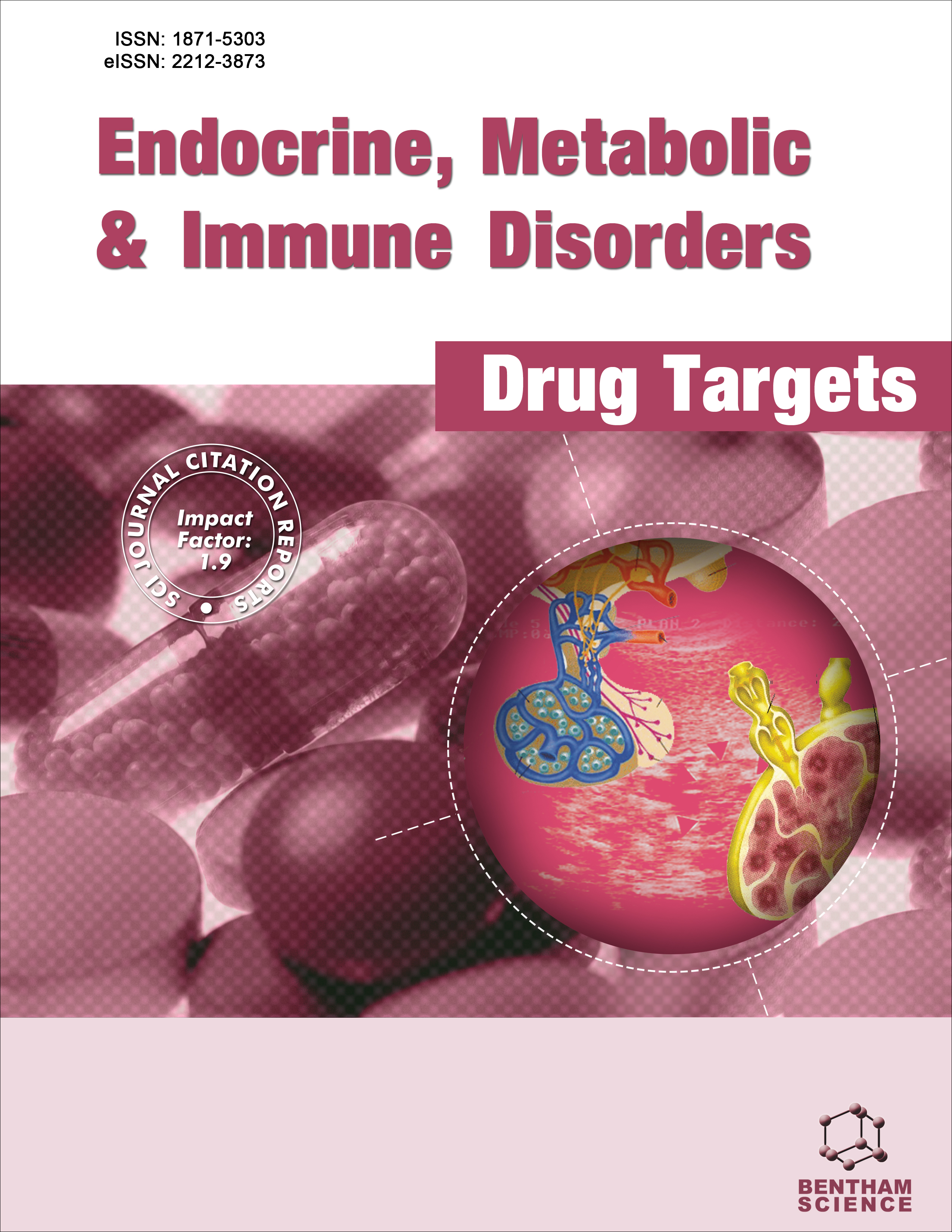- Home
- A-Z Publications
- Endocrine, Metabolic & Immune Disorders-Drug Targets (Formerly Current Drug Targets - Immune, Endocrine & Metabolic Disorders)
- Previous Issues
- Volume 11, Issue 4, 2011
Endocrine, Metabolic & Immune Disorders-Drug Targets (Formerly Current Drug Targets - Immune, Endocrine & Metabolic Disorders) - Volume 11, Issue 4, 2011
Volume 11, Issue 4, 2011
-
-
The Sphingolipid Rheostat: A Potential Target for Improving Pancreatic Islet Survival and Function
More LessAuthors: Claire F. Jessup, Claudine S. Bonder, Stuart M. Pitson and P. Toby H. CoatesBeta cell apoptosis and suboptimal islet function are implicated in the development of Type I (T1D) and Type II (T2D) diabetes, as well as the failure of the only current clinical beta cell replacement therapy for T1D, islet transplantation. Sphingosine kinase (SK) is a ubiquitous lipid kinase that controls the balance between prosurvival and proapoptotic precursors (e.g. sphingosine-1-phosphate (S1P) and ceramide, respectively), Read More
-
-
-
The Role of PPARβ/δ in the Management of Metabolic Syndrome and its Associated Cardiovascular Complications
More LessAuthors: Elisa Benetti, Nimesh S.A. Patel and Massimo CollinoThe association between metabolic syndrome and cardiovascular diseases raises important questions about the underlying pathological processes, especially for designing targeted therapeutic interventions. The Peroxisome Proliferators Activated Receptors (PPARs) are ligand-activated transcription factors that control lipid and glucose metabolism. Accumulating data suggest that PPARs may serve as potential targets for Read More
-
-
-
Ovulation, Implantation and Placentation in Females with Obesity and Metabolic Disorders: Life in the Balance
More LessAuthors: Antonio Gonzalez-Bulnes, Pilar Pallares and Cristina OviloObesity due to endocrine and metabolic disorders causing dysfunctions of appetite-regulating pathways and energy balance is an increasingly concerning issue. Such form of obesity is mainly caused by the failure of elevated levels of the hormone leptin (LEP) to suppress feeding and mediate weight loss; the syndrome, caused by disruptions of signal transduction processes at the level of leptin receptors (LEPR), has be Read More
-
-
-
FGF10 and FGF21 as Regulators in Adipocyte Development and Metabolism
More LessAuthors: Hiroya Ohta, Morichika Konishi and Nobuyuki ItohThe FGF family comprises twenty-two evolutionarily related members with diverse functions in development, metabolism, and neuronal activities. FGF10 and FGF21 play unique roles in adipocyte development and metabolism, respectively. FGF10 mediates biological responses by activating FGF receptor 2b (FGFR2b) with heparin/heparan sulfate in a paracrine manner. In contrast, FGF21 mediates biological responses by activatin Read More
-
-
-
The Impact of Bacterial Lipolysaccharides on the Endothelial System: Pathological Consequences and Therapeutic Countermeasures
More LessAuthors: T. Magrone and E. JirilloEndothelial cells (ECs) express on their membrane Toll like receptor (TLR)-4 and, therefore, are able to interact with lipopolysaccharides (LPS) or endotoxins, major constituents of the Gram-negative bacteria outer membrane. The impact of LPS on ECs can be either direct or mediated via release of cytokines and/or chemokines originated from monocytes/macrophages. In this review, the effect of the interaction between L Read More
-
-
-
Poly (ADP-Ribose) Polymerase-1 (PARP-1) as Immune Regulator
More LessAuthors: Federica Laudisi, Manolo Sambucci and Claudio PioliPoly(ADP-ribose) polymerases (PARPs) represent a family of enzymes which synthesize and bind branched polymers of ADP-ribose to acceptor proteins using NAD as a substrate. PARP-1, the prototypical representative of the family, accounts for the majority of the poly(ADP-ribose) polymer synthesis. PARP-1 functions as a DNA nick sensor and signaling molecule binding to ssDNA and dsDNA protecting cells from genomic inst Read More
-
-
-
The Regulation of FoxP3-Expressing Regulatory T Cells
More LessAuthors: Rizwanul Haque, Fengyang Lei, Xiaofang Xiong and Jianxun SongRegulatory T (Treg) cells play an important role in the maintenance of self-tolerance and are involved in the prevention of autoimmune diseases and reduce/inhibit the progression of chronic inflammatory diseases. Forkhead box P3 (FoxP3) expression in Treg cells is believed to be a critical factor in the maintenance of Treg cells suppressive function. Multiple mechanisms of action of Treg cells have been proposed, including Read More
-
Volumes & issues
-
Volume 25 (2025)
-
Volume 24 (2024)
-
Volume 23 (2023)
-
Volume 22 (2022)
-
Volume 21 (2021)
-
Volume 20 (2020)
-
Volume 19 (2019)
-
Volume 18 (2018)
-
Volume 17 (2017)
-
Volume 16 (2016)
-
Volume 15 (2015)
-
Volume 14 (2014)
-
Volume 13 (2013)
-
Volume 12 (2012)
-
Volume 11 (2011)
-
Volume 10 (2010)
-
Volume 9 (2009)
-
Volume 8 (2008)
-
Volume 7 (2007)
-
Volume 6 (2006)
Most Read This Month
Article
content/journals/emiddt
Journal
10
5
false
en


